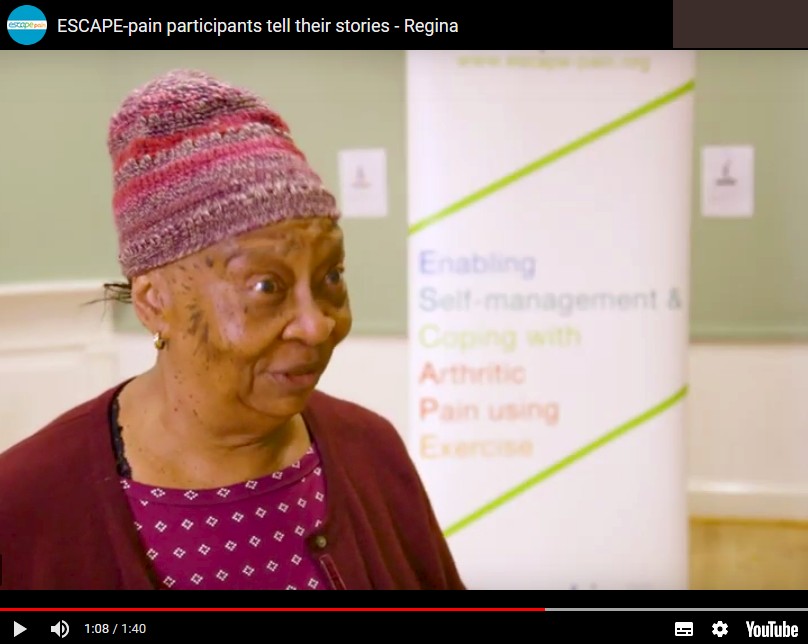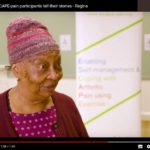Case study of improved mobility and independence
Listen to Regina’s story of how she overcame osteoarthritis and difficulties with mobility with the help of the ESCAPE-pain group at her local leisure centre.
The ESCAPE-pain Programme: Helping people with chronic joint paint to self-manage their condition and become more physically active
At 76 years old, Regina had been suffering with osteoarthritis for over ten years and it was having a big impact on her life physically and emotionally. “I was in a bad place; I was in a wheelchair to start with.”
Regina found walking very difficult and a journey that should take five minutes, would take her thirty minutes. “It came to a point where I wouldn’t dare to cross the traffic lights, and my daughter would have to drive me everywhere, because I was so scared. Of course, getting on a bus – that was way beyond me. The furthest I ever went was to church and going to church I had to have a carer because I didn’t have the confidence to go on my own.”
In 2018, Regina signed up to a programme being run by Mytime Active in a local leisure centre for chronic knee and hip pain, called ESCAPE-pain. “ESCAPE-pain has really given me my independence back, more than anything else it has given me my confidence.” From having been too scared to travel alone, Regina’s physical function improved so much so that she felt confident to be able to use buses again and travel independently.
 Regina also described how crucial the group aspect of the ESCAPE-pain programme was for her. “They make you feel comfortable even before you go into the class, and once you are there you meet other people who are like you, and you know that you are all in this together and that is what works more than anything else. I have made loads of friends at ESCAPE-pain, and I even go shopping with some of them.”
Regina also described how crucial the group aspect of the ESCAPE-pain programme was for her. “They make you feel comfortable even before you go into the class, and once you are there you meet other people who are like you, and you know that you are all in this together and that is what works more than anything else. I have made loads of friends at ESCAPE-pain, and I even go shopping with some of them.”
The programme was also important in helping her to adopt a more physically active lifestyle. “Now, I go to gym classes, I go to Zumba (it’s a dance class), and I go to yoga. I would recommend ESCAPE-pain because it makes you be yourself, I would recommend it to anybody, no matter what your state at the moment is.”
Scale of the problem
Regina’s experience is not uncommon. Osteoarthritis has a major impact on individuals, healthcare services and society. The social and economic burden of osteoarthritis is substantial and results in decreased quality of life, loss of productivity, and increasing costs of healthcare. In 2016, an estimated 30.8 million working days were lost to musculoskeletal pain in the UK, accounting for 22.4% of all sickness absence1. It is estimated that one in three people with osteoarthritis retire early, give up work or reduce the hours they work because of their condition2.
People living with osteoarthritis often believe it is an inescapable consequence of ageing and worsening disability is inevitable. Too few people with osteoarthritis receive core advice and support in line with NICE guidelines for care and management of osteoarthritis (CG177)4, 5, such as increasing physical activity and maintaining a healthy weight.
What is ESCAPE-pain?
ESCAPE-pain is an evidence-based exercise-based group rehabilitation programme for people with chronic knee and/or hip pain, also known as osteoarthritis, designed to improve people’s function by integrating exercise, education, and self-management strategies to dispel inappropriate health beliefs, alter behaviour, and encourage regular physical activity.4,6,7,8
The ESCAPE-pain programme was developed by Professor Mike Hurley and is hosted by the Health Innovation Network and supported by NHS England and Versus Arthritis.

ESCAPE-pain is shown to:
- Reduce pain, improve physical function and mental wellbeing, and improve health beliefs4.
- Sustain benefits for up to two and a half years after completing the programme6.
- Create an estimated £1.5 million total savings in health and social care for every 1,000 participants who undertake ESCAPE-pain6, 7.
Currently, over 170 sites are delivering ESCAPE-pain across the UK in both clinical and non-clinical community sites (e.g. community centres and leisure centres) with more than 11,000 people having successfully completing the programme. As ESCAPE-pain has spread into ‘real world’ settings on-going collection of outcome data from sites demonstrates that participants are benefiting from the programme.
How the programme works
Participants attend 12 sessions twice weekly for six weeks, which is led by a trained facilitator* (i.e. either a clinician or level 3-4 fitness instructor). Each session comprises a 15–20 minutes facilitated discussion on a specific topic relating to the self-management of osteoarthritis. This is followed by a 35–40 minutes individualised exercise regimen. Once participants complete the programme they are signposted to local opportunities to help them maintain their physical activity.
*All ESCAPE-pain facilitators completed an accredited 1-day training course to ensure the quality of the programme.
How to find a local class
The programme is being offered in a variety of venues from hospital physiotherapy departments to leisure centres and gyms, from church halls to community centres. To find a local class either visit the site map on the website or email your postcode to hello@escape-pain.org.
Support tools
We have designed some support tools to help people continue exercising safely in their homes once they have completed the face-to-face ESCAPE-pain programme.
See here for further information about the ESCAPE-pain app and the web-based version of the app, ESCAPE-pain Online. Both are free to access.
For more information email us at hello@escape-pain.org or visit the website escape-pain.org.
References
- Sickness absence in the labour market – Office for National Statistics [Internet]. Ons.gov.uk. 2017 [cited 1 May 2018]. Available from: https://www.ons.gov.uk/employmentandlabourmarket/peopleinwork/labourproductivity/articles/sicknessabsenceinthelabourmarket/2016
- State of Musculoskeletal Health 2018 | Arthritis Research UK [Internet]. Arthritisresearchuk.org. 2017 [cited 1 May 2018]. Available from: https://www.arthritisresearchuk.org/arthritis-information/data-and-statistics/state-of-musculoskeletal-health.aspx
- NHS England: CCG programme budgeting benchmarking tool. [Internet]. NHS England. 2014 [cited 1 May 2018]. Available from: https://www.england.nhs.uk/resources/resources–for–ccgs/prog–budgeting/
- Hurley M, Walsh N, Mitchell H, Pimm T, Patel A, Williamson E et al. Clinical effectiveness of a rehabilitation program integrating exercise, self-management, and active coping strategies for chronic knee pain: A cluster randomized trial. Arthritis & Rheumatism. 2007;57(7):1211-1219.
- National Institute for Health and Care Excellence. Osteoarthritis: care and management. Clinical guideline [CG177]. 2014.
- Hurley M, Walsh N, Mitchell H, Pimm T, Williamson E, Jones R et al. Economic evaluation of a rehabilitation program integrating exercise, self-management, and active coping strategies for chronic knee pain. Arthritis & Rheumatism. 2007;57(7):1220-1229.
- Jessep S, Walsh N, Ratcliffe J, Hurley M. Long-term clinical benefits and costs of an integrated rehabilitation programme compared with outpatient physiotherapy for chronic knee pain. Physiotherapy. 2009;95(2):94-102.
- Hurley M, Walsh N, Mitchell H, Nicholas J, Patel A. Long-term Outcomes and Costs of an Integrated Rehabilitation Program for Chronic Knee Pain: A Pragmatic, Cluster Randomized, Controlled Trial. Arthritis Care & Research. Vol. 64, No. 2, 2012, 238–247.

